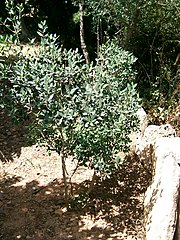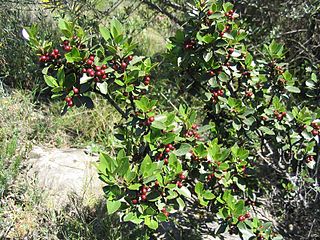Rhamnus alaternus
| Mediterranean buckthorn | |
|---|---|

| |

| |
| Flowering and fruiting sprigs with foliage | |
| Scientific classification | |
| Kingdom: | Plantae |
| Clade: | Tracheophytes |
| Clade: | Angiosperms |
| Clade: | Eudicots |
| Clade: | Rosids |
| Order: | Rosales |
| Family: | Rhamnaceae |
| Genus: | Rhamnus |
| Species: | R. alaternus
|
| Binomial name | |
| Rhamnus alaternus | |
| Synonyms | |
| |
Rhamnus alaternus is a species of flowering plant in the buckthorn family Rhamnaceae, known by the common names Italian buckthorn or Mediterranean buckthorn. It is a hardy medium-sized evergreen shrub with fragrant flowers.
Etymology
[edit]The specific Latin name alaternus, is from the Latin word for the plant. Its origin is obscure but is often suggested to be of Etruscan or pre-Indo-European Mediterranean origin.[2]
Description
[edit]Rhamnus alaternus is an evergreen shrub 1–5 metres (3 ft 3 in – 16 ft 5 in) high.[3] The stems have reddish bark and pubescent young branches, rounded and compact foliage with alternating leaves, 2–6 centimetres (0.79–2.36 in) long,[3] sometimes nearly opposite, oval or lanceolate, leathery, shiny green, yellowish-green underneath.
The small fragrant flowers are gathered in a short axillary yellow-green raceme. The flowering period extends from February to April. Fruits are obovoidal red-brownish drupes of about 3–4 millimetres (0.12–0.16 in),[3] containing from 2 to 4 seeds. The drupes darken to black when ripe.
Distribution and habitat
[edit]This species is widespread in thermophilic evergreen bush and scrubland of the Mediterranean climate regions, from Gran Canaria, Morocco and Portugal in the west, to the Levant in the east, from sea level up to 1,300 m (4,300 ft) altitude.[3][4]
Invasiveness
[edit]In Australia, where it was introduced as a garden shrub, it has become a serious invasive woody weed in many areas, especially coastal parts of SE Australia. Here it displaces native shrubs of similar size such as the sea box, Alyxia buxifolia (an endemic plant which had an important medicinal role for aboriginal people). It prevents subshrubs and herbaceous ground cover native plants from surviving due the heavy shade and competition for moisture and nutrients. It can form dense thickets with very low biodiversity.[5]
Cultivation
[edit]This species is cultivated as an ornamental garden shrub, valued for its glossy evergreen leaves and red berries. The variegated cultivar 'Argenteovariegata'[6] has gained the Royal Horticultural Society's Award of Garden Merit.[7]
Subspecies
[edit]- Rhamnus alaternus subsp. alaternus
- Rhamnus alaternus subsp. myrtifolia (Willk.) Maire
- Rhamnus alaternus subsp. pendula (Pamp.) Jafri
Gallery
[edit]-
Habit in Mallorca
-
Habit in France
-
Male flowers, South Africa
-
Foliage and fruit, Italy
References
[edit]- ^ Stephan, J. & Rivers, M.C. (2018). "Rhamnus alaternus". IUCN Red List of Threatened Species. 2018: e.T19180829A122959816. doi:10.2305/IUCN.UK.2018-2.RLTS.T19180829A122959816.en. Retrieved 9 May 2021.
{{cite journal}}: CS1 maint: multiple names: authors list (link) - ^ Walde, Alois; Hofmann, Johann Baptist (1938). Lateinisches Etymologisches Wörterbuch. Heidelberg: Carl Winter.
- ^ a b c d Pignatti S. - Flora d'Italia – Edagricole – 1982. Vol. II, pag. 78
- ^ "Rhamnus alaternus" (PDF). Flora Iberica. Retrieved 9 May 2021.
- ^ "Rhamnus alaternus". Weeds of Australia. Queensland Government. Retrieved 25 February 2021.
- ^ "RHS Plant Selector - Rhamnus alaternus 'Argenteovariegata'". Retrieved 17 February 2021.
- ^ "AGM Plants - Ornamental" (PDF). Royal Horticultural Society. July 2017. p. 84. Retrieved 23 September 2018.
- Pignatti S. - Flora d'Italia - Edagricole – 1982 Vol. II, pg. 78
- Plants.USDA
- Biolib





